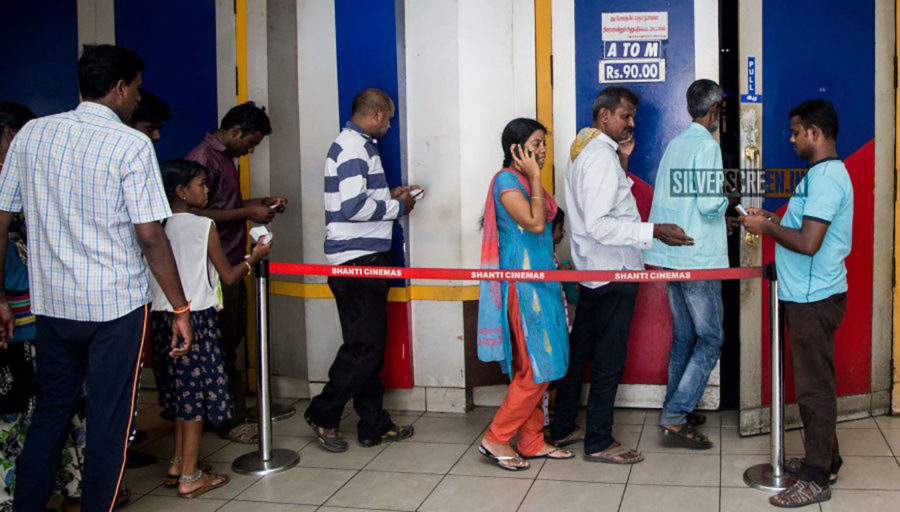On Friday, while the Madras High Court ruled that cinema halls cannot be permitted to run with more than 50% seating capacity until January 11, West Bengal Chief Minister Mamata Banerjee announced that all theatres in the state can be allowed to have 100% seating capacity, while inaugurating the 26th International Kolkata Film Festival.
The high court order came after Tamil Nadu became the first state to increase theatres’ seating occupancy to 100% since the Covid-19 pandemic measures were enforced. While fans of actors Vijay and Silambarasan were overjoyed with the decision, the Union Ministry of Home Affairs (MHA) on Wednesday asked the state government to withdraw its full theatre capacity order, stating that it dilutes the MHA’s guidelines.
Health officials said that the outcome of 100% occupancy in a closed space will be alarming.
“There’s a high possibility that at least one or two will be positive and asymptomatic among the people who are coming for one show. That one person will be able to spread it to at least 10 sitting near them and even to the people coming for the next show,” says L Ravivarman, state surveillance officer, Integrated Disease Surveillance Project.
The call to allow 100% occupancy has become louder in other states as well. After the Tamil Nadu government’s announcement, the Telugu Film Producers Council and Film Federation of India’s president, S Thanu, requested permission to increase the seating capacity in cinema halls.
Tamil Nadu’s decision to return to full seating capacity came weeks ahead of the Pongal festival, which will be seeing the theatrical releases of some big-budget films, including Vijay-starrer Master on January 13, and Silambarasan’s Eeswaran on January 14. After the state government’s announcement, a Facebook post by Aravinth Srinivas, a junior resident doctor of JIPMER in Puducherry, went viral on Tuesday where he addressed actors Vijay, Silambarasan, and the state government saying that a 100% occupancy was “a suicide attempt” and that healthcare workers like him were “tired”.
This is so, so very sad 😔 pic.twitter.com/KuHj8KpBbV
— Karthik (@beastoftraal) January 5, 2021
While research by Celluloid Junkie has found that “not a single outbreak of COVID-19 anywhere across the globe can be traced to a cinema, multiplex or public screening venue”, the Centers for Disease Control and Prevention (CDC) says going to a theatre is considered a high-risk activity.
Talking to Silverscreen India, Dr Ravivarman said that since a theatre brings many people indoors together at the same time and they are all exposed to the virus for at least two-three hours, it’s riskier than schools or restaurants. He says that the reason no cases were traced to theatres could be because they have just started re-opening.
“The nature of the disease is that it spreads by saliva droplets. If it is an enclosed space, the possibility of those droplets staying in the air is more. In the current situation itself, at least 1,000-2,000 people are testing positive for Covid-19. But surely another 10,000 people around them are positive without having any knowledge of the same. So, if these people turn up in a movie theatre, there’s a 100% chance that at least two out of 100 will be positive. And these two people can spread it to at least half of the theatre capacity because just recording the temperature of the person won’t tell us whether they are positive or not. So I definitely do not recommend going to a theatre and watching a film,” he says.
According to a study by the Hermann-Rietschel-Instituts der Technischen Universität in Berlin, Germany, undertaken on behalf of German cinema trade body HDF: “If you only breathe in the cinema, the number of inhaled aerosols is still well below that in an office where people are speaking, even with an excessively long film. According to the study, this is also related to the type of ventilation in the cinemas.”
However, Srividya, state epidemiologist, Directorate of Health, Puducherry, says that no health worker will recommend anyone to visit a theatre with full occupancy.
“As of now, we did not discover a cluster from movie theatres. But in the past, we have seen social gatherings leading to huge clusters. Capacity of 50% is recommended and that is the way for things to gradually open up. There will be no social distancing and no doubt the euphoria of watching a full theatre film will be huge. So, we anticipate the first-day first-show will be uncontrollable, if the situation comes up,” she says.
According to both Dr Srividya and Dr Ravivarman, carrying masks, sanitisers, and following strict social distancing are the only ways to manage the situation. They also recommend people to eat healthy food to increase immunity.

Rakesh Gowthaman, managing director of Vettri Theatres, said while SOP’s are being followed, no additional guidelines have been issued.
“We are waiting for the final order, regarding the occupancy numbers. If 100% is allowed, we will have bouncers and we will make sure the audience doesn’t remove masks and maintain decorum inside the theatre. We will make sure no unruly celebrations happen inside the theatres,” he says.
He says that he hasn’t heard of cases being reported from theatres in Tamil Nadu, and added that there were many other places which were functioning with full capacity.
“If you look at political gatherings, restaurants, people are there without masks eating, talking, etc. My opinion is if are you asking theatres to perform with 50% capacity, other industries should also follow suit. Tamil Nadu government studied the drop in cases and only then took this decision, it is not because Vijay went and asked for it,” Gowthaman said.
Recommended
Currently, India has 2,25,449 cases of Covid-19 active. According to a bulletin by the Press Information Bureau, the recovery rate in the country stands at 96.36%. However, the current rate of the mutant Covid-19 cases is above 80, as of Friday.
The CDC recommends that anyone who participates in a higher-risk activity, like visiting a cinema hall, should spend the next 14 days staying at home as much as possible, avoiding contact with people who have underlying conditions that put them at risk for Covid-19, and getting tested for the virus.



